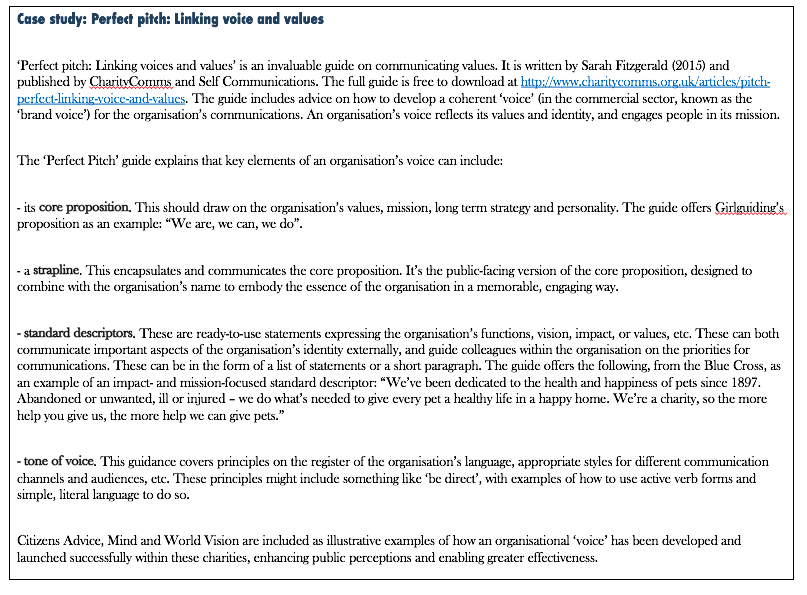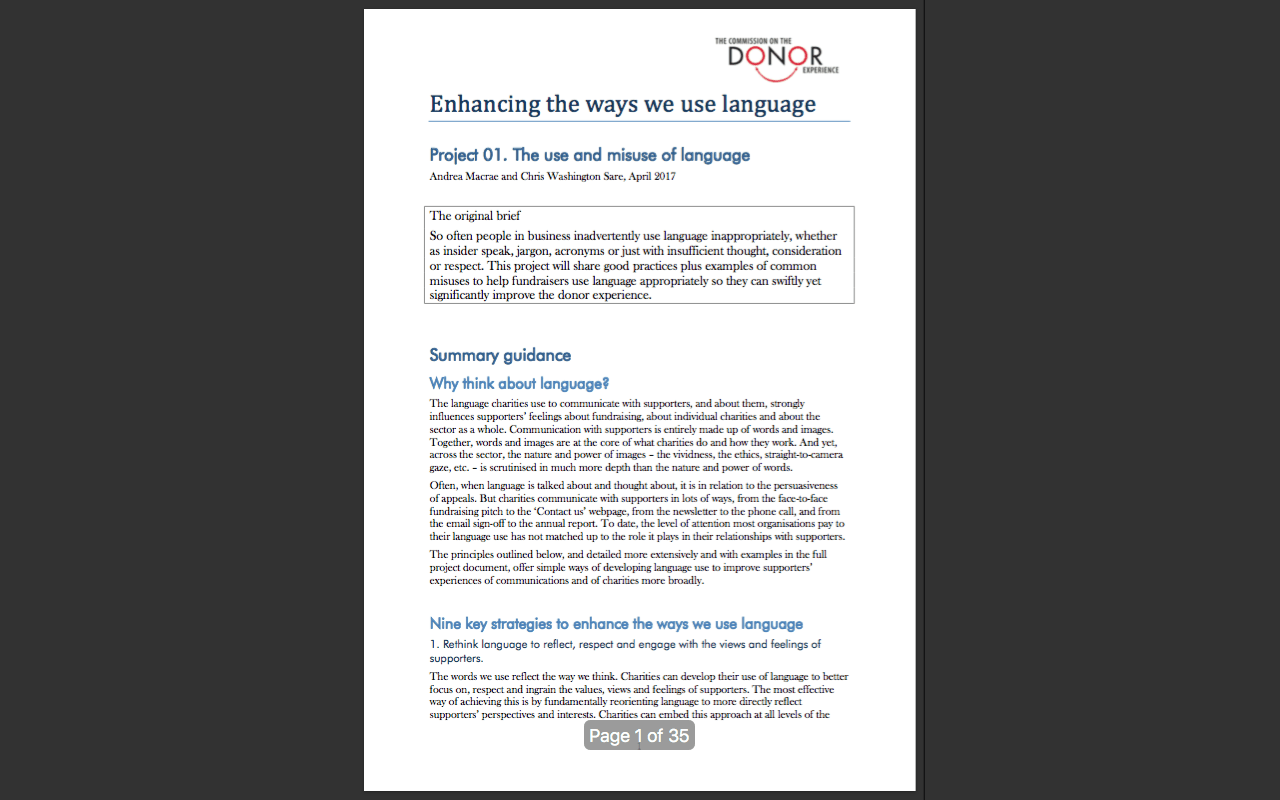CDE project 1 section 4: communicate values, and do it consistently.
- Written by
- The Commission on the Donor Experience
- Added
- April 28, 2017
Enhancing the ways we use language
CDE Project 1: The use and misuse of language
Andrea Macrae and Chris Washington Sare, April 2017
Reviewed by Matthew Sherrington
4. Communicate values, and do it consistently.
The degree to which a brand shares the values of its consumers is a significant determiner of customer loyalty and satisfaction. [1] Exactly the same dynamic has been found between charities and their supporters. [2] Evidence suggests that a supporter will feel more positively towards a charity, and feel more satisfied by its communications, if the charity and the supporter share some values. [3]
Of course, in order for a supporter to be able to recognise a charity as having shared values, the charity must have and express some values in the first place. A study by Sargeant and Woodliffe found that “the extent to which individuals believe that they have deepened their knowledge of the organisation thought the communications they receive” will “impact positively” on the individual’s relationship with the organisation. [4] The Relationship Fundraising review proposes that supporters’ trust in and loyalty to a charity “may be enhanced by […] making it clear what values the organisation espouses, […] communicating not only the content of service provision to beneficiaries, but also the style, manner or ethos underpinning that delivery.” [5] This suggests that supporters will feel more positively towards a charity, and feel more satisfied by its communications, if the charity clearly communicates its values, ethos and identity. This may in part be because this allows charities to better manage, and therefore better meet, supporters’ expectations. [6]
[1] See, for example, Jamal, A., & Goode, M. M. H. (2001), ‘Consumer and brands: A study of the impact of self-image congruence on brand preference and satisfaction’. Marketing Intelligence & Planning, vol. 19, pp. 482-492; Sirgy M. J., Grewal, D., Mangleburg, T. F., Park, J., Chon, K., Claiborne, C. B., & Berkman, H. (1997), ‘Assessing the predictive validity of two methods of measuring self-image congruence’, Journal of the Academy of Marketing Science, vol. 25, pp. 229-241; Sirgy, M. J., Johar, J., Samli, A., & Claiborne, C. B. (1991), ‘Self-congruity versus functional congruity: Predictors of consumer behavior’, Journal of the Academy of Marketing Science, vol. 19, pp. 363-375.
[2] Bennett, R. (2009), ‘Factors influencing donation switching behaviour among charity supporters: An empirical investigation’, Journal of Customer Behaviour, vol. 8, issue 4, pp. 329-345; MacMillan, K., Money, K., Money, A. and Downing, S. (2005), ‘Relationship marketing in the not-for-profit sector: An extension and application of the commitment-trust theory’, Journal of Business Research, vol. 58, pp. 806-818; Sargeant, A. and Woodliffe, L. (2007), ‘Building donor loyalty: The antecedents and tole of commitment in the context of charity giving’, Journal of Nonprofit and Public Sector Marketing, vol. 18, issue 2, pp.47-68.
[3] Hibbert, S. (2016), ‘Charity communications: Shaping donor perceptions and giving’, in The Routledge Companion to Philanthropy, eds T. Jung, S. D. Phillips, and J. Harrow (London, Routledge), pp.102-115.
[4] Sargeant and Woodliffe study referenced in footnote 18 above, this conclusion from the study being summarised in Sargeant, A. (2016), Relationship fundraising: Where do we go from here? Vol. 1, Plymouth: Centre for Sustainable Philanthropy, Plymouth University. pp. 21-22.
[5] Sargeant, A. (2016), Relationship fundraising: Where do we go from here? Vol. 1, Plymouth: Centre for Sustainable Philanthropy, Plymouth University, p. 20.
[6] nfpSynergy’s ‘Brand Awareness Monitor’ reveals the level of public familiarity with a charity’s organisational identity, and can indicate the relative strength of that organisational identity in shaping public perceptions of the charity (in comparison to other factors, such as transitory media stories).





















